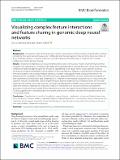Visualizing complex feature interactions and feature sharing in genomic deep neural networks
Author(s)
Liu, Ge; Zeng, Haoyang; Gifford, David K
Download12859_2019_Article_2957.pdf (5.964Mb)
Publisher with Creative Commons License
Publisher with Creative Commons License
Creative Commons Attribution
Terms of use
Metadata
Show full item recordAbstract
BACKGROUND: Visualization tools for deep learning models typically focus on discovering key input features without considering how such low level features are combined in intermediate layers to make decisions. Moreover, many of these methods examine a network’s response to specific input examples that may be insufficient to reveal the complexity of model decision making. RESULTS: We present DeepResolve, an analysis framework for deep convolutional models of genome function that visualizes how input features contribute individually and combinatorially to network decisions. Unlike other methods, DeepResolve does not depend upon the analysis of a predefined set of inputs. Rather, it uses gradient ascent to stochastically explore intermediate feature maps to 1) discover important features, 2) visualize their contribution and interaction patterns, and 3) analyze feature sharing across tasks that suggests shared biological mechanism. We demonstrate the visualization of decision making using our proposed method on deep neural networks trained on both experimental and synthetic data. DeepResolve is competitive with existing visualization tools in discovering key sequence features, and identifies certain negative features and non-additive feature interactions that are not easily observed with existing tools. It also recovers similarities between poorly correlated classes which are not observed by traditional methods. DeepResolve reveals that DeepSEA’s learned decision structure is shared across genome annotations including histone marks, DNase hypersensitivity, and transcription factor binding. We identify groups of TFs that suggest known shared biological mechanism, and recover correlation between DNA hypersensitivities and TF/Chromatin marks. CONCLUSIONS: DeepResolve is capable of visualizing complex feature contribution patterns and feature interactions that contribute to decision making in genomic deep convolutional networks. It also recovers feature sharing and class similarities which suggest interesting biological mechanisms. DeepResolve is compatible with existing visualization tools and provides complementary insights.
Date issued
2019-07-19Department
Massachusetts Institute of Technology. Computer Science and Artificial Intelligence LaboratoryJournal
BMC Bioinformatics
Publisher
BioMed Central
Citation
Liu, Ge, Haoyang Zeng, and David K. Gifford. "Visualizing complex feature interactions and feature sharing in genomic deep neural networks." BMC Bioinformatics 20 (July 2019): no. 401 doi 10.1186/s12859-019-2957-4 ©2019 Author(s)
Version: Final published version
ISSN
1471-2105